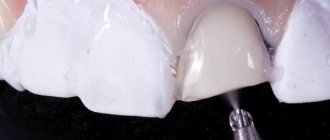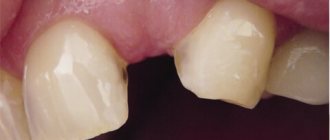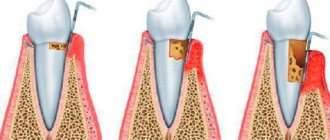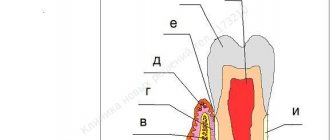Periodontal disease is a set of pathological processes that spread to the tissues surrounding the teeth and holding them in the alveoli. According to statistics, pathologies belonging to this group are diagnosed in 90% of the adult population. Moreover, most often diseases of this type are detected in men and women aged 37-45 years.
In the absence of timely and competent treatment, periodontal diseases can cause loosening and premature tooth loss, the appearance of foci of chronic infection in the oral cavity, deterioration of the body’s immune status and the development of other complications. That is why modern dentists pay increased attention to the development of methods and means for treating pathologies belonging to this group.
Structure and functions of periodontium
Periodontium is usually called a complex of tissues that includes:
- alveolar processes (areas of the jaw that bear the dentition);
- gums (mucous membranes covering the alveolar processes);
- periodontium (tissues consisting of protein fibers and located in the space between the alveolar plate and the cement of the tooth root);
- cement (special bone tissue covering the roots and necks of teeth).
In the human body, the periodontium performs the following functions:
- shock-absorbing (evenly distributes the load on the jaws);
- supporting-retaining (provides strong fixation of the tooth in the alveolar socket);
- trophic (contains an extensive network of lymphatic and blood vessels, a huge number of nerve receptors);
- barrier (protective) and others.
Preserving periodontal tissue in a healthy state is the key to long-term and proper functioning of the masticatory apparatus.
Periodontomas
Periodontal diseases include various tumors and tumor-like processes in periodontal tissues. Diseases can manifest themselves in different ways and disrupt the aesthetics and function of periodontal tissues. Periodontal disease can be caused by genetic predisposition, trauma, or chronic inflammation. They are treated primarily surgically: removal and further histological examination to confirm the diagnosis. In most cases, periodontal tumors are benign and have a favorable prognosis. But any pathology requires timely and qualified treatment. Periodontal diseases include:
I. Gingival fibromatosis. This is a rare pathology that occurs due to genetic disorders. It manifests itself as gum growth, enlargement of the alveolar process of the jaw, and overlap of dental crowns. Accompanied by dysfunction, aesthetic defect, and accumulation of dental plaque.
II. Fibroma. It is a small mobile tumor of connective tissue. It has a dense consistency, clear edges, and smooth structure. It does not hurt, but creates an aesthetic defect. If injured, it may bleed and become inflamed.
III. Epulis. A tumor-like formation that occurs due to local trauma, tissue irritation or chronic inflammation. Depending on the morphology, epulis can be granulomatous, fibrous and giant cell.
IV. Lipoma. Refers to benign neoplasms from adipose tissue. It rarely appears on the gums and arises from the fat cells of the submucosal layer. The tumor grows slowly, feels soft to the touch and is tightly fused to the gum.
Causes of periodontal disease development
Factors that increase the likelihood of developing periodontal disease are:
- heredity;
- hypovitaminosis;
- failure to comply with hygiene requirements;
- presence of dental plaque;
- dental anomalies (bite disorders and others);
- somatic diseases (malfunctions of the nervous system, gastrointestinal diseases, diabetes mellitus, cardiac and endocrine disorders);
- smoking;
- weakened immune system;
- non-compliance with drinking regime;
- habit of breathing through the mouth;
- the presence in the oral cavity of low-quality fillings, orthodontic or orthopedic structures incorrectly installed in dentistry.
In addition, the risk of disease directly depends on the place of residence, lifestyle, characteristics of professional activity and dietary habits of patients.
Treatment at home
Treating gums at home is only possible if simple gingivitis or papillitis occurs. For this purpose, the mouth is rinsed with decoctions of medicinal herbs and a salt-soda solution. It is impossible to treat flux on the gums and other diseases on your own. If any symptoms occur, you should consult a doctor, undergo professional therapy, and follow the instructions of a specialist at home.
The dentist recommends performing the following procedures at home:
Carry out thorough hygienic brushing of teeth;
Rinsing with a salt-soda solution, which is effective against inflammation;
Rinsing with a decoction of medicinal herbs. The decoction has anti-inflammatory, antiseptic, antimicrobial, deodorizing and wound-healing properties;
Apply medications.
Symptoms of periodontal disease
The first symptoms indicating the occurrence of periodontal disease are:
- tingling, itching, numbness in the gums;
- bleeding of gum tissue;
- swelling of the interdental papillae;
- thickening of the gingival margin;
- detachment of gums from dental crowns.
In the future, the clinical picture may be supplemented by:
- gradual exposure of the necks of the teeth;
- redness, hyperemia of the gums;
- formation of pathological gum pockets;
- increase in interdental spaces;
- gradual loosening of teeth.
Symptoms of tissue diseases also include increased sensitivity of dental tissues to irritants, as well as aching pain in the affected area.
Classification and symptoms
Pathological damage to the tissues surrounding the dentition, in most cases, occurs as a result of an imbalance between bacterial symbiosis and oral tissues. There are 5 main categories:
- Gingivitis is an inflammation of the marginal part of the gum mucosa adjacent to the teeth, occurring without disturbing the position and mobility of the teeth. Accompanied by swelling, redness, pain and bleeding. The main cause is periodontal pathogens: Porphyromonas gingivalis, Aggregatibacter actinomycetemcomitans and other gram-negative anaerobic coccobacilli. Under the influence of their toxins, a change in the structure of the tissues of the dental epithelial junction occurs, which serves as a barrier that prevents the penetration of infectious agents towards the tooth root. There are several forms: catarrhal (occurs in 97% of cases), hypertrophic, ulcerative-necrotic. The outcome of gingivitis can be complete restoration of periodontal tissue. Without adequate treatment, it turns into periodontitis and threatens adentia.
- Periodontitis is an inflammation of periodontal tissues, accompanied by progressive destruction of soft tissues and atrophy of the jaw bone. The causes are usually poor hygiene, mechanical injuries and hypersensitivity to certain medications. Risk factors include hormonal and general metabolic disorders, immunodeficiency states, malocclusions, hypertonicity of the masticatory muscles, etc. The disease develops gradually, and at the initial stage does not cause noticeable discomfort. Early manifestations may include bleeding, soreness and changes in the shape and color of the gums, and the appearance of bad breath. As the process progresses, periodontal pockets deepen, alveolar processes are destroyed, which leads to loosening and tooth loss. In severe cases of the disease, pus may be released from the periodontal pocket and an increase in body temperature may be noted.
- Periodontal disease is a dystrophic lesion of the periodontium, accompanied by gradual resorption of bone tissue. Periodontal disease is less common and, as a rule, is one of the symptoms of hypertension, atherosclerotic changes in blood vessels, neurogenic or endocrine pathologies. The difference between periodontitis and periodontal disease is that with periodontitis there is always an inflammatory process, while with periodontal disease it is absent. With periodontal disease, gum pockets do not form, there is no purulent discharge, and tooth displacement occurs only in severe forms of the disease when the root is more than half exposed. At the initial stage of the disease, there is usually no discomfort. Patients with moderate severity of periodontal disease experience burning, itching, and hyperesthesia. In severe cases of periodontal disease, due to loss of bone tissue, interdental spaces – trema – are formed between the teeth. A fan-shaped divergence of the crowns is observed.
- Idiopathic lesions. These include a number of general somatic diseases, one of the clinical manifestations of which is the progressive lysis of periodontal tissue (Papillon-Lefebvre, Hand-Schueller-Christian syndrome, neutropenia, immunodeficiency states, acatalasia, etc.). The causes of idiopathic periodontal pathologies are not completely clear. The leading role is played by genetic predisposition. Patients develop deep periodontal pockets with the release of exudate, displacement and loosening of dental units. Characterized by rapidly progressing resorption of bone tissue with the formation of oval-shaped cavities.
- Periodontomas are benign tumor and tumor-like pathologies of the periodontium: gingival fibromatosis, epulis, periodontal cyst, etc. They usually develop as a result of chronic irritation of soft tissues by destroyed tooth walls, sharp edges of deep-set crowns, and incorrectly modeled clasps of a removable denture.
Treatment of periodontal diseases
The general treatment program for periodontal diseases includes:
- removal of microbial plaque and mineralized deposits from the surface of teeth;
- caries therapy;
- preventing functional overload of certain areas of the dentition;
- rejection of bad habits;
- carrying out orthodontic treatment (if indicated);
- anti-inflammatory therapy;
- combating systemic diseases;
- the use of drugs that enhance immunity, stimulate osteogenesis and activate the adaptive and protective functions of the body;
- carrying out general hygiene measures (monitoring the regime of work, nutrition, rest, hygiene).
The treatment regimen for periodontal diseases is drawn up taking into account all manifestations of the disease and the results of a comprehensive examination of the patient. Timely seeking of professional help by a patient significantly improves the prognosis of the disease, shortens the duration of treatment and avoids the development of complications.
Papillitis
Papillitis is the inflammation of the gingival papilla, which fills the interdental space. Inflammation of the papilla occurs due to exposure to traumatic factors, temperature irritants, viral or bacterial agents, or as a result of an allergic reaction. In rare cases, the cause of the pathology is metabolic disorders, exacerbation of diseases of internal organs, hormonal disorders, etc.
Types and symptoms of the disease
Inflammation can be of several types depending on its course: acute and chronic. The acute form of papillitis is of two types:
Catarrhal - characterized by simple inflammation of tissues;
Ulcerative – accompanied by the formation of small lesions – ulcers, the appearance of acute pain;
Chronic papillitis occurs:
Catarrhal - simple inflammation becomes chronic. It is characterized by hyperemic, bluish papillae, which are slightly enlarged in size. With prolonged existence, resorption of the bone interdental septum is possible;
Ulcerative - characterized by the formation of ulcers and erosions that do not heal for a long period of time;
Hypertrophic - accompanied by the growth of gingival papillae and an increase in their size. In this case, pain may be absent.
Papillitis is manifested by inflammation of one or more interdental papillae on one or both sides of the dentition (internal and external). Symptoms of the disease are redness, swelling of the tissues, an increase in the size of the papilla, pain, discomfort, and unpleasant sensations. The pain may increase while eating. With severe inflammation, the gingival papilla can interfere with the closure of teeth.
Diagnosis and treatment
Diagnosis of the disease is based on clinical examination and patient history. X-ray examination for papillitis is rarely performed, since the disease almost never affects the bone. In some clinical cases, x-rays are necessary to differentiate papillitis from gingivitis and periodontitis.
Treatment is aimed at eliminating the cause of the pathology, healing the gums, and eliminating discomfort. Inflammation of the papilla caused by a household injury or during eating often goes away on its own within 2-5 days. Other types of disease require consultation with a doctor and professional treatment. Therapy includes simple procedures: professional cleaning, medication applications, mouth baths and rinses. Treatment depends on the cause and is selected individually in each specific case. The prognosis for papillitis is favorable, recovery is complete. In difficult cases and in the absence of therapy, inflammation can spread and develop into gingivitis and periodontitis.
Stomatitis
Stomatitis is a dental disease in which inflammation of the oral mucosa occurs. There are several types of disease that arise due to different reasons. Stomatitis in children has slightly different manifestations; the disease should be treated by a specialist.
Types and causes of stomatitis
The disease exists in the following forms:
1. Allergic – occurs as a result of an allergy to something, is not a separate disease, but refers to the general reaction of the body;
2. Aphthous. The cause of the disease is considered to be chronic diseases of the gastrointestinal tract, various allergies, genetic predisposition and viruses;
3. Herpetic stomatitis occurs when exposed to the herpes virus, which is transmitted by contact or airborne droplets;
4. Candidal (fungal) stomatitis is an inflammation due to damage to the mucous membrane by fungi of the genus Candida. The disease occurs more often in children and the elderly;
5. Ulcerative occurs when there is a disease of the internal organs (stomach, intestines, cardiovascular system, blood or infectious diseases) and manifests itself very acutely;
6. Catarrhal stomatitis is an acute inflammation due to allergies, trauma, stress, hormonal changes, and poor hygiene.
7. The traumatic form of the disease occurs when the mucous membrane is injured and bacteria enter. Trauma can be mechanical, thermal, chemical.
Symptoms of stomatitis
The symptoms of the disease will depend on the cause and type. Stomatitis is characterized by redness, swelling, and soreness of the mucous membrane. Ulcers, blisters, plaque, itching, unpleasant and painful sensations may occur in the mouth. General symptoms may occur: headache, weakness, fever, nausea. Treatment of stomatitis should be carried out by a specialist, since only he can diagnose and fully eliminate the disease.
Treatment of stomatitis
The goal of treatment will be to determine the cause of the disease, eliminate it and treat symptoms. Dental measures must be comprehensive, complete and effective. To treat stomatitis in adults, antimicrobial, anti-inflammatory, antihistamine, and antibacterial agents are used. Treatment of the underlying disease, professional oral hygiene, and applications to the affected areas of the mucosa are carried out.
Treatment for stomatitis in children will differ from that in adults. For children, drugs that are milder but more effective are selected. There are many folk remedies, but do not forget that it is much safer and more correct to consult a specialist - a dentist. Dental clinic "DENTLEY" provides high-quality medical services. Our doctor will prescribe medications and cure your stomatitis. Call and make an appointment as soon as you feel discomfort in the oral mucosa.







